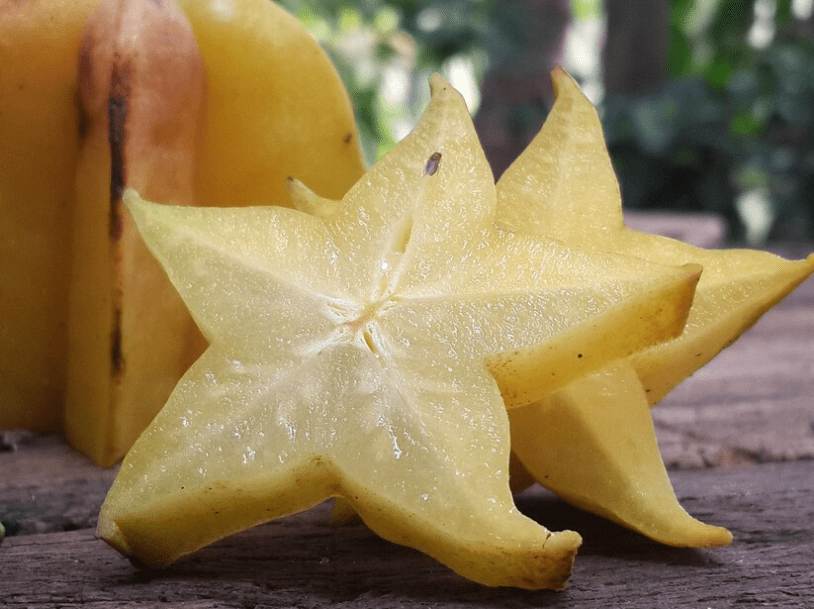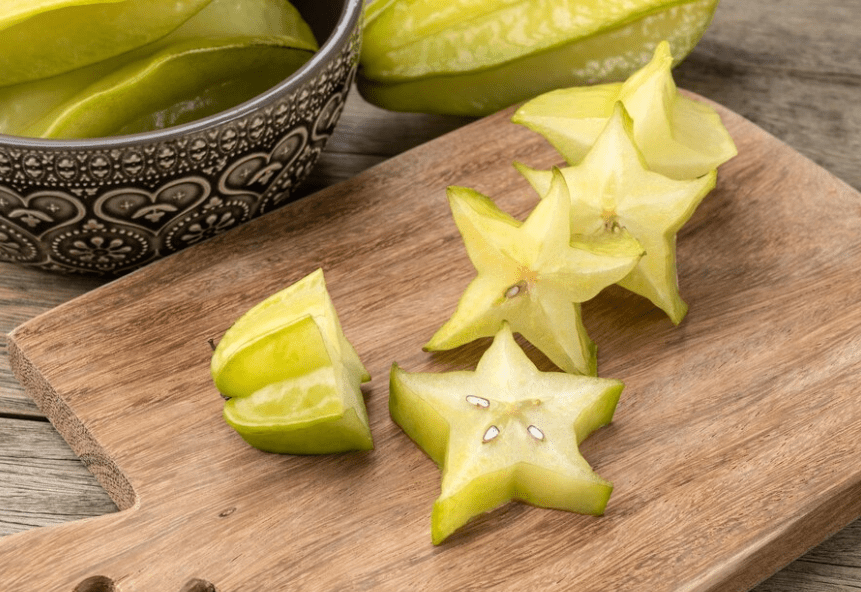Star fruit, also known as carambola, is a tropical fruit celebrated for its distinctive star-like shape when cut crosswise. Native to Southeast Asia, this fruit has gained popularity worldwide due to its unique taste and impressive health benefits. In this article, we will explore the various health benefits and uses of star fruit, emphasizing why it deserves a place in your diet.
Nutritional Profile of Star Fruit
Star fruit is low in calories but rich in essential nutrients, making it an excellent addition to a balanced diet. A single medium-sized star fruit (about 91 grams) provides:
- Calories: 28
- Carbohydrates: 6 grams
- Fiber: 2.5 grams
- Vitamin C: 34.4 mg (57% of the Daily Value)
- Vitamin A: 15 mcg (2% of the Daily Value)
- Folate: 12 mcg (3% of the Daily Value)
- Potassium: 124 mg (4% of the Daily Value)
- Magnesium: 10 mg (2% of the Daily Value)

Health Benefits of Star Fruit
1. Rich in Antioxidants
Star fruit is packed with antioxidants such as vitamin C, which helps neutralize harmful free radicals in the body. Antioxidants play a crucial role in protecting cells from oxidative stress, reducing inflammation, and lowering the risk of chronic diseases like heart disease and cancer.
2. Boosts Immune System
The high vitamin C content in star fruit supports a robust immune system. Vitamin C enhances the production of white blood cells, which are essential for fighting infections. Regular consumption of star fruit can help keep colds, flu, and other illnesses at bay.
3. Supports Digestive Health
Star fruit is an excellent source of dietary fiber, which aids in digestion by promoting regular bowel movements and preventing constipation. Fiber also supports gut health by fostering a healthy balance of gut bacteria, which can improve overall digestive function.
4. Promotes Heart Health
The potassium and magnesium in star fruit contribute to heart health by helping to regulate blood pressure and maintain a steady heartbeat. Additionally, the fiber content helps lower cholesterol levels, reducing the risk of heart disease.
5. Aids in Weight Management
Low in calories and high in fiber, star fruit is an ideal snack for those looking to manage their weight. The fiber helps you feel full longer, reducing overall calorie input and precluding gluttony.
6. Supports Skin Health
Vitamin C in star fruit is essential for collagen production, a protein that keeps skin firm and elastic. Regular consumption of star fruit can help improve skin texture, reduce the appearance of wrinkles, and promote a youthful complexion.
7. Enhances Eye Health
Star fruit contains vitamin A and other essential nutrients that support eye health. Regular consumption of star fruit can help prevent eye conditions such as cataracts and age-related macular degeneration, ensuring better vision as you age.
8. Regulates Blood Sugar Levels
The fiber in star fruit not only aids in digestion but also helps regulate blood sugar levels. By slowing the absorption of sugar into the bloodstream, star fruit can help prevent spikes in blood sugar, making it a good option for people with diabetes or those at risk of developing the condition.
9. Reduces Inflammation
Star fruit has anti-inflammatory properties that can help reduce inflammation in the body. This makes it salutary for individualities with seditius conditions similar as arthritis . Consuming star fruit regularly may help alleviate symptoms and improve joint health.
10. Improves Respiratory Health
Star fruit is traditionally used in some cultures to treat respiratory conditions. Its high vitamin C content helps reduce mucus and phlegm, making it effective in alleviating symptoms of respiratory infections such as bronchitis and asthma.

Uses of Star Fruit
Culinary Uses
Star fruit’s sweet and tangy flavor makes it a versatile ingredient in various culinary dishes. Here are some popular ways to enjoy star fruit:
- Fresh Consumption: Enjoy star fruit raw by slicing it into star-shaped pieces. It makes a refreshing and healthy snack.
- Salads: Add star fruit to fruit salads or green salads for a burst of flavor and a visually appealing presentation.
- Smoothies: Blend star fruit with other fruits and vegetables to create delicious and nutritious smoothies.
- Desserts: Use star fruit as a topping for yogurt, ice cream, or cakes to add a tropical twist to your desserts.
- Salsas: Combine star fruit with ingredients like tomatoes, onions, and cilantro to make a unique and zesty salsa.
- Juices and Cocktails: Extract the juice of star fruit to make refreshing beverages or use it as an exotic ingredient in cocktails.
Medicinal Uses
Star fruit has been used in traditional medicine for its therapeutic properties. While scientific research is ongoing, some traditional uses include:
- Cough Relief: The juice of star fruit is believed to help alleviate coughs and sore throats.
- Fever Reduction: Star fruit has been used to lower fevers and treat infections.
- Anti-inflammatory: Some cultures use star fruit to reduce inflammation and treat skin conditions like eczema.
Precautions When Consuming Star Fruit
While star fruit is generally safe for most people, there are a few precautions to keep in mind:
- Kidney Disease: Star fruit contains oxalates, which can be harmful to individuals with kidney disease. Consumption may lead to kidney stones or other complications.
- Antipathetic Reactions: Some people may be antipathetic to star fruit, experiencing symptoms like itching, hives, or swelling. However, exercise caution, if you have a known fruit mislike.
- Drug Interactions: Star fruit can interact with certain medications, similar to grapefruit. If you are on medication, consult your healthcare provider before adding star fruit to your diet.
Growing and Harvesting Star Fruit
Star fruit trees thrive in tropical and subtropical climates. Here are some tips for growing and harvesting star fruit:
- Climate: Ensure the tree is planted in a warm, frost-free environment with plenty of sunlight.
- Soil: Plant star fruit trees in well-drained soil rich in organic matter.
- Watering: Keep the soil consistently moist but not waterlogged. Star fruit trees require regular watering, especially during dry periods.
- Fertilization: Use a balanced fertilizer to promote healthy growth and fruit production.
- Pruning: Prune the tree to maintain its shape and remove any dead or diseased branches.
- Harvesting: Star fruit is ready to harvest when it turns yellow and feels slightly soft to the touch. Gently twist the fruit off the tree to avoid damage.
Conclusion
Star fruit is a delicious and nutritious fruit that offers numerous health benefits and versatile culinary uses. From boosting immune function to promoting heart health, this tropical fruit is a valuable addition to any diet. However, individuals with kidney disease or potential allergies should exercise caution. Whether enjoyed fresh, in salads, or as part of a refreshing beverage, star fruit is a star performer in the world of healthy eating.
By incorporating star fruit into your diet, you can enjoy its unique flavor while reaping its many health benefits. So, the next time you come across this exotic fruit, don’t hesitate to give it a try!
Topics covered
- What is Star Fruit?
- What are key nutrients in Star Fruit?
- What are health benefits of Star Fruit?
- How to use Star Fruit?
- Recipes of Star Fruit.







